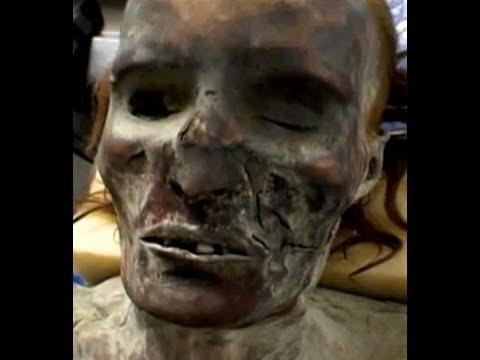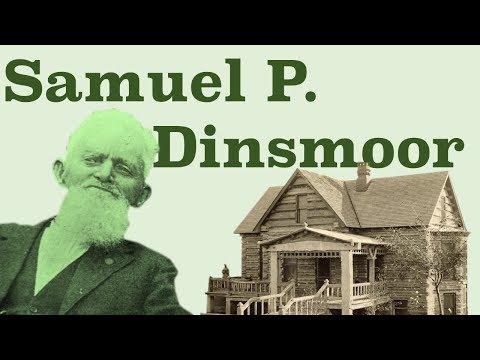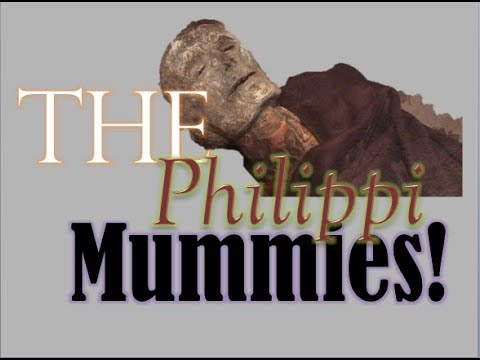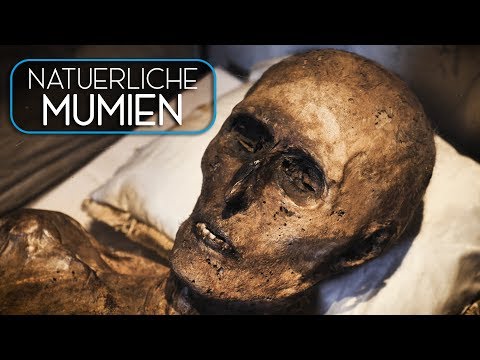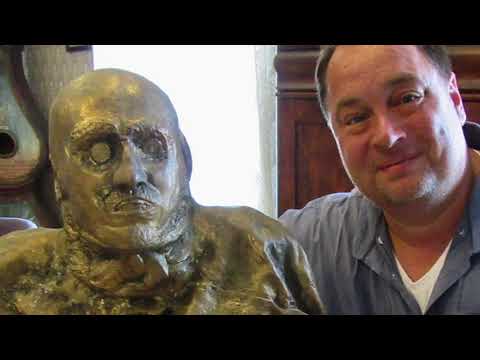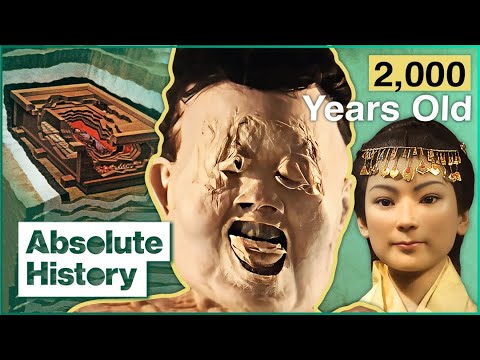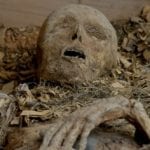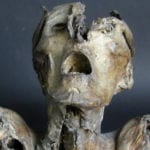However, even when death is indisputable, the thought of burying a loved one’s body in the earth or at sea, of reducing the corpse to ashes inside a crematorium, or of the cadaver’s lying unclaimed in an unmarked grave or in a remote area of the wilderness represents a horrible prospect. There is another possibility, equally appalling, although unlikely: after death, a persons’ corpse, embalmed or mummified, might be put on public display, as an exhibit visitors would pay to see. For we who yet live, this list of 10 creepy corpses that were on public display at one time or another suggests just how ghastly and gruesome such a posthumous fate would be.
10 Luang Pho Daeng
Born in 1894 on Thailand’s Koh Samui Island, Luang Pho Daeng, a Buddhist monk, gave up the ghost in 1973 while meditating. His mummified body, still in the attitude he had adopted at the time of his death, is now on display in a golden, glass-sided case in the Wat Khunaram temple. According to an article concerning him, Luang Pho Daeng was originally ordained as a monk when he was a young man. However, he left the clergy to marry, fathering six children. When they reached adulthood, he devoted the rest of his life to Buddhism and was again ordained. Traveling to Bangkok, he learned more about his faith. On the island of Koh Samui, off Thailand’s east coast, he began meditating in a cave in Tham Yai (present-day Tamarind Springs) before returning to his family home behind the Wat Khunaram temple. As he approached the age of 80, Luang Pho Daeng, having had a premonition that his death was nigh, assembled his students, making his last wishes known to them. If his body began to decompose, it was to be cremated with his ashes scattered at the famous “Saam Jaeg” or three-forked intersection in Hua Thanon. However, if his body did not decompose, it should be put on display in an upright coffin as an inspiration to “future generations to follow Buddhist teachings and be saved from suffering.” Although his corpse lost its eyes when they moved back into his head, his remains, otherwise, are in excellent condition, and sunglasses, provided by the temple’s monks, prevent his appearance from looking too ghastly.[1] Another article on the monk points out that gecko eggs sometimes hatch inside his body, and some of the eggs “have been found in his eye sockets, [in his] mouth and beneath his skin during radiography scans,” heightening the exhibit’s creepy effect.
9 Speedy Atkins
After his demise, Charles Henry “Speedy” Atkins (1875–1928) was headed for a pauper’s grave. Instead, his mummified corpse was stored in a funeral home’s closet. Occasionally, locals or tourists were allowed a free look at what was left of him. According to the Chicago Sun-Times, Atkins proved a popular attraction. When it came time, 66 years after his death, to bury his remains, 200 folks took pictures next to the open casket as they gathered to pay him “a rousing farewell,” along with their respects, during a funeral service at the Washington Street Baptist Church in Paducah, Kentucky. The embalmer’s widow, Velma Hamock, said, “I never saw a dead man bring so much happiness to people.” The secret of Atkins’s longevity as a corpse was the special embalming fluid that undertaker A. Z. Hamock used. Its chemicals and ingredients enabled Hamock to preserve like the way “Egyptians preserved mummies.” Unfortunately, Hamock took the secret of his preservative with him to his own grave. When Atkins drowned while fishing, there was no one to claim the body—no family nor friends. Hamock sought permission from the local coroner to experiment on Atkins’s remains and use his new embalming fluid. The condition of Speedy’s remains proved the merits of the preservative; over six-and-a-half decades after his death, Mrs. Hamock marveled that Speedy was “not stinking” and had not “lost all his features.” He also had the reverence and regard of his hometown if the attendance at his much-delayed funeral is an indication.[2]
8 Elmer McCurdy
Train robber Elmer McCurdy (1880–1911) “swore he’d never be taken alive,” The Evening Independent newspaper advised its readers. He wasn’t. Elmer McCurdy was shot to death by an Oklahoma sheriff’s posse. Afterward, he started a new career as a “fun house dummy.” McCurdy’s mummified corpse spent its time in a museum’s warehouse when it wasn’t painted to glow in the dark and hung from the gallows of an amusement park’s funhouse. The newspaper article reports that McCurdy’s corpse also appeared as a prop in an episode of The Six Million Dollar Man television series. However, no one knew as much until one of the mummy dummy’s arms “fell off” and a technician, attempting to glue the detached limb back in place, saw human bone where none should have been. After the coroner also located a bullet in McCurdy’s stomach, the body’s identity was found by tracing the sale and purchase of the “prop” by various carnivals and exhibitions. First, the sheriff of the posse who shot him sold McCurdy’s corpse to the owner of a carnival, where it was mummified. After that, the outlaw’s cadaver was purchased by several others before it was turned over to carnival owner Louis Sonney as security for a loan that the borrower failed to repay. McCurdy then became a star in Sonney’s traveling freak show until the end of World War II, when such attractions lost their appeal. Sold to the Hollywood Wax Museum, the mummy was later purchased by the Nu-Pike Amusement Park, which painted and hung it from its exhibit’s gallows. The corpse’s final appearance was at its long-delayed funeral. His final resting place is in the Summit View Cemetery in Guthrie, Oklahoma, where “a laconic tombstone mentions the year of his death and burial, without explaining why the dates are 66 years apart.” [3]
7 Hazel Farris
Today, her hair is mostly gone. Her eyes are missing. Most of her nose has disappeared. She has lost many of her teeth. Not much flesh remains on her bones. The ring finger on her right hand is gone as well. What’s left of Hazel Farris does not have much left on its bones. Farris (c. 1880–1906) shot five men, killing them all, before killing herself to avoid being captured. Her husband was the first to die when, drinking, he took umbrage at her intention to buy a new hat. The couple eventually came to blows. Naturally, Farris shot him. Twice. When neighbors, hearing the gunfire, notified the police, three lawmen stormed the house. They, too, became fatalities, thanks to Farris’s “outrage, steel nerve, and deadly aim.” Neighbors spied a passing deputy sheriff and apprised him of the situation. He entered Farris’s home, and, during a struggle with the murderous housewife, he stumbled over one of the bodies. His gun went off, and the bullet shot off the ring finger of his opponent’s right hand. The mishap didn’t seem to faze Farris. Freeing herself from the lawman, she shot him, adding the fifth kill to her tally, before escaping out the back door. In Bessemer, Alabama, the 25-year-old fugitive found herself smitten by a man. She trusted him with her story, at which point he informed the local constabulary, most likely for a reward. Farris poisoned herself to avoid being taken into custody. After her body dehydrated at a combination furniture store/ funeral home, the local populace, roused by talk about “Hazel the Mummy,” paid a dime each to view her desiccated corpse. Her remains were subsequently bought by carnival showman Orlando C. Brooks and shown to the public “for the benefit of science”—and a hefty fee. A poster advertising the exhibition assured the public that “‘Hazel’ affords you a study worth while,” guaranteeing her to be a genuine mummy and offering to forfeit $500 to anyone, doctors included, who could prove otherwise.[4]
6 Samuel Perry Dinsmoor
Smack-dab in the American heartland, The Garden of Eden, in Lucas, Kansas, boasts a collection of 150 sculptures, all made of concrete, which express the political and religious views of a retired schoolteacher and American Civil War veteran, sculptor Samuel Perry Dinsmoor (1843–1932). Watch this video on YouTube An eccentric, Dinsmoor was a populist who, after retiring, began the art project that would carry him through the remaining 25 years of his life. First, though, he set his hand to building his limestone domicile, which resembles a log cabin and includes such flourishes as concrete porch spindles formed inside bottles that he broke after the material hardened. The amateur architect, a natural-born showman, described the cabin as “the most unique home for living or dead on Earth.” According to the Kansas Historical Society, he next started work on his garden of sculptures over the next quarter-century using 113 tons of concrete to sculpt his take on “the Bible and modern civilization as interpreted through his populist views.” The Garden of Eden also includes a concrete mausoleum that now contains his own remains and those of his wife. After he died, his body was mummified and laid to rest inside the concrete burial chamber, so visitors can glimpse his remains through the glass portion of the mausoleum’s concrete lid. His wife’s body reposes, unseen, in the sealed portion of the crypt below him.[5]
5 The West Virginia Philippi Mummies
Another strange location to find mummified remains: a train station in Philippi, West Virginia. This quaint building also houses the Barbour County Historical Museum, which displays items from as far back as 1635. The wide variety of guns, knives, and cannons mingle with a historic switchboard, newspapers, ceramics, and flags. But in a small room at the back of the museum—which might have been a bathroom at one point—lies the remains of two women. And for one dollar, you can take a peek at them! Graham Hamrick, a farmer, amateur scientist, and shopkeeper, got caught up in the late nineteenth-century Egyptomania craze and became obsessed with learning their mummification technique (Hm, sounds familiar). After experimenting with fruits and meats, as well as small animals, he wanted to try his method on a human. He purchased two corpses from the Trans-Allegheny Lunatic Asylum, also known as the West Virginia Hospital for the Insane. Unfortunately, this was not an uncommon practice at that time as unscrupulous mental health hospitals disposed of some patients, especially those with no family, in corrupt and horrendous ways. It was also reported that he secured the remains of an infant and a hand. Like Hamock above, his process is unknown as Hamrick took the formula to the grave—a normal, six-feet-under grave. These mummies briefly toured with circus great P.T. Barnum before returning to WV. They were then displayed throughout the state, being stored at various times in a barn and “under a local man’s bed for a while.” In 1985, Philippi experienced a flood, which damaged the mummies; however, after some time “drying in the sun,” they finally made their way to their current home in the museum. The infant was too damaged after the flood, and the hand was lost at some point.[6]
4 Sir Christian Friedrich von Kahlbutz
The mummified remains of Sir Christian Friedrich von Kahlbutz (1651–1702) put the town of Kampehl, Germany, population 130, on the map. The knight’s body is also a tourist draw. It seems that the corpse has shown no signs of decay during the nearly 320 years following his demise. In 1991, though, not everyone in the village was happy to have the cadaver on hand. Mayor Edmund Bublitz, for one, opposed the presence of the preserved body, despite its ability to attract as many as 150,000 visitors each year who are eager to gawk at the town’s star attraction. “During the Communist era,” a Los Angeles Times story explains, the decedent’s occupation of its glass-topped crypt was not a problem. The state managed the tourist attraction, charging a viewing fee and paying the local Lutheran church where the tomb is located for its use. The church’s pastor at the time, Peter Freimark, defended the attraction but admitted that its popularity was due to the fascination of people for its “macabre, obscene, cruel, grisly and…erotic” aspects, explaining that such lurid qualities were near and dear to the German heart. The “erotic” feature of the knight’s presence apparently stems from his lifetime interest in the pursuit of the fair sex, with members of whom he fathered 30 illegitimate children in addition to his 11 legitimate heirs, the Times article suggests, as well as Sir Christian’s claim that he possessed the right to “deflower all brides in his fiefdom.” When a groom’s beloved rebuffed the knight, her fiancé was found with a split skull soon after, and Sir Christian was charged with the murder. The accused maintained his innocence, however, as he supposedly declared, “If I am the murderer, may it be God’s will that my body never decay.” The state’s and the church’s battle over Sir Christian continued to wage until 1990, when East Germany was reunified with West Germany. However, the conflict between the church’s pastor and the town’s mayor did not end with Germany’s reunification. The mayor, determined to display Sir Christian’s remains on city property, had arranged for six out-of-work men to remove the knight’s body from the church’s crypt and transport it to the fire station. Before they began their labors, however, the mayor tried “to push through a proposal to relocate the mummy” but failed. Afterward, he told the laborers to stand down: the body-snatching had been called off. Undisturbed in his glass-covered crypt, Christian Friedrich von Kahlbutz continues to draw paying customers. At present, the score in the conflict between church and state seems to be, Church, 2; State, 0.[7]
3 Charles Eugene de Croy
St. Nicholas’s Church in Tallinn, Estonia, is also the home of a mummified corpse, Charles Eugene de Croy (1651–1702). The Rough Guide to the Baltic States: Estonia, Latvia, and Lithuania tells its readers that the duke’s body occupies a “side chapel near the main entrance.” In life, his claim to fame was that he led the Russian army at Narva in 1701; during his command, he opted to fight rather than flee, as his soldiers did. His act of courage resulted in his becoming a prisoner of Sweden’s King Charles XII. After the duke’s death the following year, no one would spring for the cost of a proper burial, so he was propped up in the chapel instead. Not long after, “protected from decay by dry weather,” his body became an attraction, until 1897, at any rate, when “authorities finally saw fit to stick it in the ground.”[8] The ghastly appearance of the body is apparent in a visitor’s description included in an 1883 book. Although coiffed and well-attired, the corpse is, nevertheless, frightful. He is described as having a startling-looking face with a grey complexion. With an apparently injured nose and thin lips, its body a yellowish-brown.
2 Christian Jacobsen Drakenberg
Christian Jacobsen Drakenberg (1626–1772) was a seafaring man, right up to the moment of his capture, at age 68, by Algerine pirates, during a 1694 voyage to Spain. After escaping his captors, he made his way back to Denmark, where he became a favorite at parties thrown by the aristocracy—it appears Drakenberg was a bit of a storyteller, the more outrageous, the better. However, what is most extraordinary about him is that he is alleged to have lived to the ripe old age of 145, making the observation in the 1856 English Cyclopaedia: A New Dictionary of Universal Knowledge that Drakenberg’s lifespan represents “one of the most extraordinary instances of longevity on record,” an astounding understatement. After his death, he was mummified and displayed at the cathedral at Aarhus. For decades, it was customary to slyly open the casket and pluck a hair from the sailor’s chin. In 1835, Drakenberg was in excellent condition, “a kind of natural mummy.” But at the command of the queen, he was given a proper burial in 1840 under the cathedral floor.[9]
1 Xin Zhui
Also known as Marquise Dai, Xin Zhui (c. 217 BC–168 BC) was wed to the Marquis Dai of the Western Han Dynasty. As Joseph William Lewis, Jr., M.D., points out in Did They Rest in Peace?: Misadventures of Corpses That Probably Did Not, her body was unearthed in December 1971, during the excavation of an air raid shelter near an army hospital in Hunan Province. According to Lewis, her wooden burial chamber, which itself had been buried beneath “a layer of thick white clay and 11,000 pounds of charcoal to thwart water intrusion into the tomb,” also contained the remains of her husband, a child, and more than 3,000 cultural artifacts. The method of her entombment and burial maintained a constant temperature and humidity, creating a “deficit [of] oxygen and antisepsis,” Lewis observes. As a result, her body remained very well-preserved, while those of her companions, suffering exposure to moisture, were subject to the natural effects of decay. Due to her body’s condition, its skin was supple, the joints flexible, and the internal organs had “escaped decay,” Lewis says, and her superior preservation allowed for her blood to be typed. They were also able to determine a likely cause of death. She suffered from heart disease, probably dying of a heart attack at about age 50, which was brought on by her fondness for “too much rich food and too little exercise.” A secret compound, injected into her body’s circulatory system, ensured that the preservation of her corpse would continue, and her body was put on display at the Hunan Municipal Museum in Changssha.[10]



